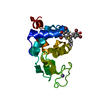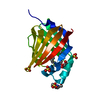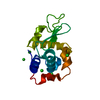Entry Database : PDB / ID : 5u1mTitle Structure of the IRS-1 PTB Domain Bound to the Juxtamembrane Region of the Insulin Receptor Insulin receptor Insulin receptor substrate 1 Keywords / / / / Function / homology Function Domain/homology Component
/ / / / / / / / / / / / / / / / / / / / / / / / / / / / / / / / / / / / / / / / / / / / / / / / / / / / / / / / / / / / / / / / / / / / / / / / / / / / / / / / / / / / / / / / / / / / / / / / / / / / / / / / / / / / / / / / / / / / / / / / / / / / / / / / / / / / / / / / / / / / / / / / / / / / / / / / / / / / / / / / / / Biological species Homo sapiens (human)Method / Resolution : 1.8 Å Authors Eck, M.J. / Dhe-Paganon, S. Journal : Nat Commun / Year : 2017Title : Domain-dependent effects of insulin and IGF-1 receptors on signalling and gene expression.Authors : Cai, W. / Sakaguchi, M. / Kleinridders, A. / Gonzalez-Del Pino, G. / Dreyfuss, J.M. / O'Neill, B.T. / Ramirez, A.K. / Pan, H. / Winnay, J.N. / Boucher, J. / Eck, M.J. / Kahn, C.R. History Deposition Nov 28, 2016 Deposition site / Processing site Revision 1.0 Sep 13, 2017 Provider / Type Revision 1.1 Nov 6, 2024 Group / Database references / Structure summaryCategory chem_comp_atom / chem_comp_bond ... chem_comp_atom / chem_comp_bond / database_2 / pdbx_entry_details / pdbx_modification_feature Item / _database_2.pdbx_database_accession
Show all Show less
 Yorodumi
Yorodumi Open data
Open data Basic information
Basic information Components
Components Keywords
Keywords Function and homology information
Function and homology information Homo sapiens (human)
Homo sapiens (human) X-RAY DIFFRACTION / Resolution: 1.8 Å
X-RAY DIFFRACTION / Resolution: 1.8 Å  Authors
Authors Citation
Citation Journal: Nat Commun / Year: 2017
Journal: Nat Commun / Year: 2017 Structure visualization
Structure visualization Molmil
Molmil Jmol/JSmol
Jmol/JSmol Downloads & links
Downloads & links Download
Download 5u1m.cif.gz
5u1m.cif.gz PDBx/mmCIF format
PDBx/mmCIF format pdb5u1m.ent.gz
pdb5u1m.ent.gz PDB format
PDB format 5u1m.json.gz
5u1m.json.gz PDBx/mmJSON format
PDBx/mmJSON format Other downloads
Other downloads 5u1m_validation.pdf.gz
5u1m_validation.pdf.gz wwPDB validaton report
wwPDB validaton report 5u1m_full_validation.pdf.gz
5u1m_full_validation.pdf.gz 5u1m_validation.xml.gz
5u1m_validation.xml.gz 5u1m_validation.cif.gz
5u1m_validation.cif.gz https://data.pdbj.org/pub/pdb/validation_reports/u1/5u1m
https://data.pdbj.org/pub/pdb/validation_reports/u1/5u1m ftp://data.pdbj.org/pub/pdb/validation_reports/u1/5u1m
ftp://data.pdbj.org/pub/pdb/validation_reports/u1/5u1m Links
Links Assembly
Assembly
 Components
Components Homo sapiens (human) / Gene: IRS1 / Production host:
Homo sapiens (human) / Gene: IRS1 / Production host: 
 Homo sapiens (human) / Gene: INSR / Production host:
Homo sapiens (human) / Gene: INSR / Production host: 
 X-RAY DIFFRACTION / Number of used crystals: 1
X-RAY DIFFRACTION / Number of used crystals: 1  Sample preparation
Sample preparation ROTATING ANODE / Type: ELLIOTT GX-13 / Wavelength: 1 Å
ROTATING ANODE / Type: ELLIOTT GX-13 / Wavelength: 1 Å Processing
Processing Movie
Movie Controller
Controller












 PDBj
PDBj
















